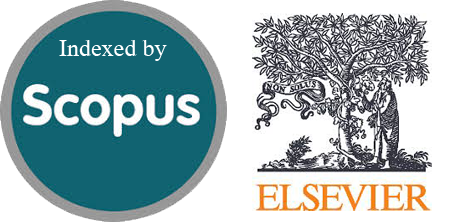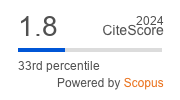Software as a Service-based Integrated Interactive Online Course System
Abstract
Several online learning platforms use recorded videos as a medium for delivering their material. In addition, several applications, such as Zoom, Google Meet, and WhatsApp, can help communicate interactively during this learning process. However, because the application is still separate from the existing online learning platform, users must switch applications and make the necessary data settings. Another obstacle experienced is that not all online learning service providers can have the infrastructure to use online learning systems, especially if the providers are individuals. This research uses a simple sequential method and aims to build an integrated online course system equipped with an interactive learning management system that many online courses, in general, can use. The main features are submissions of new courses by teachers, ordering courses by students, classes can be held using live video streams, the interaction between teachers and students in real-time with live chat, and a learning management system that includes sending and receiving assignments and quizzes. The test results show that as many as 73.2% of respondents gave the highest score for the built system.
Downloads
References
D. Bylieva, Z. Bekirogullari, V. Lobatyuk, and T. Nam, “Analysis of the Consequences of the Transition To Online Learning on the Example of Mooc Philosophy During the Covid-19 Pandemic,” Humanit. Soc. Sci. Rev., vol. 8, no. 4, pp. 1083–1093, 2020, doi: 10.18510/hssr.2020.84103.
G. Zainuddin et al., “A Systematic Literature Review on Massive Open Online Course for Language Learning,” Creat. Educ., vol. 10, no. 12, pp. 3195–3204, 2019, doi: 10.4236/ce.2019.1012243.
M. Zheng, D. Bender, and C. Lyon, “Online learning during COVID-19 produced equivalent or better student course performance as compared with pre-pandemic: empirical evidence from a school-wide comparative study,” BMC Med. Educ., vol. 21, no. 1, pp. 1–11, 2021, doi: 10.1186/s12909-021-02909-z.
B. Devara, “Ruang Guru,” 2021. https://www.ruangguru.com/ (accessed Nov. 16, 2021).
J. S. Jones, K. P. Ragan, H. D. Witte, and Y. J. Zhang, “The impact of online learning tools on student success in college of business core finance classes,” J. Educ. Bus., vol. 0, no. 0, pp. 1–8, 2021, doi: 10.1080/08832323.2021.1932705.
Hendra Sahputra Batubara, Nizwardi Jalinus, Waskito, and Ronal Watrianthos, “Study on 11th Grade SMK Imelda Medan Teachers’ and Students’ Perceptions of Online Learning,” Research in Technical and Vocational Education and Training, vol. 1, no. 2, Jun. 2022.
Y. C. Liao et al., “How Can We Support Online Learning for Elementary Students? Perceptions and Experiences of Award-Winning K-6 Teachers,” TechTrends, vol. 65, no. 6, pp. 939–951, 2021, doi: 10.1007/s11528-021-00663-z.
T. C. Sandanayake, S. P. Karunanayaka, and A. P. Madurapperuma, “A framework to design open educational resources-integrated online courses for undergraduate learning: A design-based research approach,” Educ. Inf. Technol., vol. 26, no. 3, pp. 3135–3154, 2021, doi: 10.1007/s10639-020-10393-z.
P. Modisane and O. Jokonya, “Evaluating the benefits of Cloud Computing in Small, Medium and Micro-sized Enterprises (SMMEs),” Procedia Comput. Sci., vol. 181, no. 2019, pp. 784–792, 2021, doi: 10.1016/j.procs.2021.01.231.
F. Tuma and J. Aljazeeri, “Asynchronous group learning in learn from the learner approach: A Learning Object That Enhances and Facilitates Distance Self and Shared Learning,” Ann. Med. Surg., vol. 67, no. May, p. 102535, 2021, doi: 10.1016/j.amsu.2021.102535.
B. Soldatov and N. Soldatova, “Distance education didactic principles application in teaching,” E3S Web Conf., vol. 273, 2021, doi: 10.1051/e3sconf/202127312031.
O. Dönmez and Y. Akbulut, “Timing and relevance of secondary tasks impact multitasking performance,” Comput. Educ., vol. 161, no. October 2020, 2021, doi: 10.1016/j.compedu.2020.104078.
A. Levitskyi, I. Benzar, V. Vitiaz, D. Golovatiuk, and O. Karabenyuk, “Teaching Pediatric Surgery in The Online Environment Challenges and Opportunities,” Int. J. online Biomed. Eng., vol. 17, no. 5, pp. 119–132, 2021, doi: 10.3991/ijoe.v17i05.22051.
D. S. Sweetman, “Making virtual learning engaging and interactive,” FASEB BioAdvances, vol. 3, no. 1, pp. 11–19, 2021, doi: 10.1096/fba.2020-00084.
H. B. Rosenthal et al., “A near-peer educational model for online, interactive learning in emergency medicine,” West. J. Emerg. Med., vol. 22, no. 1, pp. 130–135, 2021, doi: 10.5811/WESTJEM.2020.12.49101.
M. Warr and C. Sampson, “Achieving Critical Dialogue in Online Doctoral Programs: an Exploration of Student Perceptions and Experiences with Multiple Modalities,” TechTrends, vol. 64, no. 6, pp. 860–867, 2020, doi: 10.1007/s11528-020-00499-z.
R. Sudiana, “Efektifitas Penggunaan Learning Management System Berbasis Online,” vol. 9, no. 2, pp. 201–209, 2016.
E. Hernawati and P. Aji, “Perancangan dan Penerapan Konten e-Learning melalui Learning Management System dalam Meningkatkan Motivasi Belajar,” J. Inf. Syst. Eng. Bus. Intel., vol. 2, no. 1, pp. 23–32, 2016.
I. T. Ali, “Analisis Hubungan Implementasi Multimedia pada Learning Management System terhadap Kemampuan Mahasiswa dalam Penguasaan Materi Pembelajaran,” J. Sains dan Teknol., vol. 10, no. 1, pp. 1–7, 2011, [Online]. Available: http://jst.eng.unri.ac.id/index.php/jst/article/view/96.
U. Rahardja, Q. Aini, and S. R. Zuliana, “Metode Learning Management System (LMS) Idu Untuk Mendukung Kegiatan Belajar Mengajar MIT Pada Perguruan Tinggi Raharja,” Cices, vol. 2, no. 2, pp. 156–172, 2016, doi: 10.33050/cices.v2i2.311.
N. Alias and A. Zainuddin, “Innovation for better teaching and learning: Adopting the learning management system,” Malaysian online J. Instr. Technol., vol. 2, no. 2, pp. 27–40, 2005.
A. Farid, “ANALISIS TINGKAT PENGANGGURAN DI INDONESIA TAHUN 1980-2007 Farid Alghofari Fakultas Ekonomi Universitas Diponegoro Semarang,” Anal. Tingkat Pengangguran di Indones. Tahun 1980-2007, pp. 1–31, 2007.
D. L. Fithri, A. P. Utomo, and F. Nugraha, “Implementation of SaaS Cloud Computing Services on E-Learning Applications (Case Study: PGRI Foundation School),” J. Phys. Conf. Ser., vol. 1430, no. 1, 2020, doi: 10.1088/1742-6596/1430/1/012049.
K. A. Garov, L. Y. Yovkov, and L. I. Rusenova, “Cloud-based e-learning,” TEM J., vol. 7, no. 2, pp. 286–292, 2018, doi: 10.18421/TEM72-07.
B. Liu, H. Chen, and H. Junmei, “Design and implementation of university continuing education informatization platform based on SaaS model,” 15th Int. Conf. Comput. Sci. Educ. ICCSE 2020, no. Iccse, pp. 253–256, 2020, doi: 10.1109/ICCSE49874.2020.9201626.
G. Greeff and R. Ghoshal, “Practical E-Manufacturing and Supply Chain Management,” in Software project management, 2004, pp. 358–377.
A. Adenowo and B. A. Adenowo, “Software Engineering Methodologies: A Review of the Waterfall Model and Object-Oriented Approach Malaria detection software tools View project Software Engineering Methodologies: A Review of the Waterfall Model and Object-Oriented Approach,” Artic. Int. J. Sci. Eng. Res., vol. 4, no. 7, pp. 427–434, 2013, [Online]. Available: http://www.ijser.org.
Copyright (c) 2023 Jurnal RESTI (Rekayasa Sistem dan Teknologi Informasi)

This work is licensed under a Creative Commons Attribution 4.0 International License.
Copyright in each article belongs to the author
- The author acknowledges that the RESTI Journal (System Engineering and Information Technology) is the first publisher to publish with a license Creative Commons Attribution 4.0 International License.
- Authors can enter writing separately, arrange the non-exclusive distribution of manuscripts that have been published in this journal into other versions (eg sent to the author's institutional repository, publication in a book, etc.), by acknowledging that the manuscript has been published for the first time in the RESTI (Rekayasa Sistem dan Teknologi Informasi) journal ;








